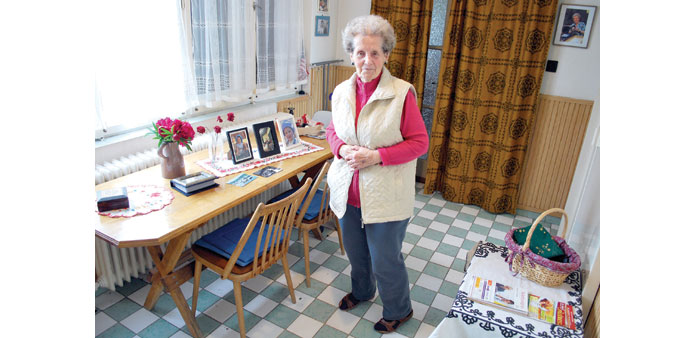By Gregor Mayer
|
|
The Iron Curtain once ran across the water Lake Neusiedl. In the days when people would take extreme risks to escape communism, many thought of swimming across the water from Hungary to democratic Austria.
This is the story of a woman who managed a beach on the Hungarian side, where the body of water is known as Lake Ferto, and her role in changing the course of world history.
From Hungary, you can look across and see the church steeple of Moerbisch over in Austria.
It was 25 years ago, in the summer of 1989, that citizens of communist East Germany, vacationing in Hungary, were longingly looking at that church steeple and all it symbolised — freedom in the West. Europe was still divided between the capitalist West and communist East, but that division was slowly but steadily starting to dissolve, and it was in this corner of Hungary, in the town of Fertorakos, only a few kilometres from the border, that an independent minded woman took a risk.
Agnes Baltigh happened to speak fluent German and knew a lot about the lake.
“I was already a pensioner back then. I could earn a bit of extra money selling the tickets to use the beach,” recalls Baltigh, now 88.
The reform-oriented communist government of Hungary had begun to dismantle massive border barriers with Austria. It was June 27, 1989 that Hungarian Foreign Minister Gyula Horn and his Austrian counterpart, Alois Mock, cut through the last section of fence between their countries. The infamous “Curtain,” a metaphorical term for the heavily patrolled border, was starting to dissolve.
Barely four and a half months later, on November 9, the Berlin Wall would open, ushering in the collapse of communism throughout eastern Europe.
In 1988, Hungary had already begun to allow its people to travel as often as they wanted to the West on a passport no longer limited to the communist world. East Germans did not get that benefit, but in the wake of the rule change, Hungary’s border guards were getting tired of having to intercept citizens of other communist states, above all East Germany, from sneaking past the patrols to get to the West.
During that summer of 1989, tens of thousands of East Germans “extended” their vacations in Budapest or on popular Lake Balaton while trying to scout out the best place to make a bid to cross the “green” border of fields and lakes with Austria.
This is where Agnes Baltigh’s story began.
“One day a local border-guard commander drove up to me on the beach and simply told me, ‘Aunt Agi, from today onwards, all the people from the eastern countries, including East Germany, can come all the way down to the lake edge.’”
Hungary was reducing surveillance, but not abolishing it completely.
Barely had the officer departed when three Trabant cars pulled up, filled with smiling young East Germans. “Can you help us?” they asked her. “Can we swim across the lake to Austria?”
Baltigh advised them against that, as there were still border guards in speedboats patrolling the lake. But the young East Germans wouldn’t be dissuaded: “We don’t want to go back to the GDR, that crappy world there!”
So she took pity on them and thought about how she could help. She didn’t know the paths through the forests near the border area, but she had a friend, Hilda, who did know some back trails that would lead across the “green” border.
Baltigh passed the information on to the young East Germans, who succeeded in sneaking across to Austria. Soon the word spread like wildfire among the other East German vacationers about the “good fairy” who could help them out.
“Aunt Agi” was not only a person with information and tips, but also one who spontaneously shored up peoples’ courage and even provided crisis counselling.
“Some were really frightened of being caught and taken back to the GDR, where ‘fleeing the republic’ was a punishable crime,” she said.
“Some stayed overnight in my house. I gave them a real pep talk, and asked a man named Pal Teigesze - he has since passed away - and who had a tiny vintner’s house on the border, to drive them over to Austria.”
Initially she had to overcome her own fears. Was the reforming communist state really so gentle as it proclaimed, or would her boss at the beach report her activities to the Hungarian secret police and get her in trouble?
Those East Germans who did safely reach Austria would send her postcards with coded messages: “Thank you, the medicine worked immediately,” was a typical message signalling that the escape had succeeded.
The mass escapes added to the crisis which climaxed with all the communist regimes stepping down.
For Agnes Baltigh, each postcard brought satisfaction. Her own dream as a young girl to study medicine and become a paediatrician had been thwarted by the communist regime. Between the two world wars, her father had taught in an officers’ training school, and so her whole family was reviled as belonging to the “enemy class” of society.
Agnes became a nurse instead, working alongside her husband, the district doctor. The couple raised four children and found fulfilment, she said. Her husband died shortly before the East German vacationers arrived seeking her help.
Her eyes now glisten and her cheeks redden when thinking about the events of the summer of 1989 in her village of Fertorakos.
“I am happy that I helped out some of the people back then,” she says modestly. Despite her advanced age, Agnes Baltigh is lively and robust. And perhaps it is the knowledge that she made so many people happy that has kept her so young. —DPA

